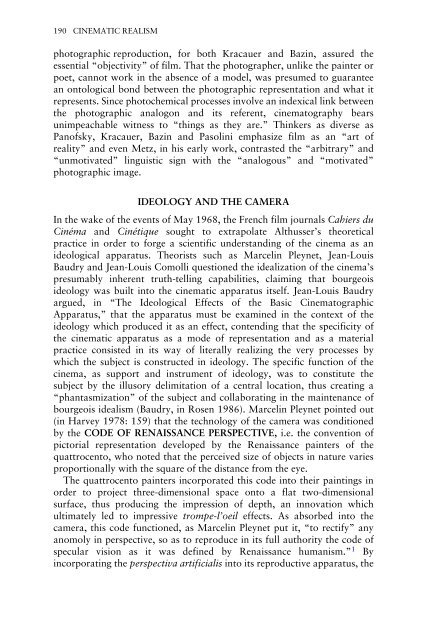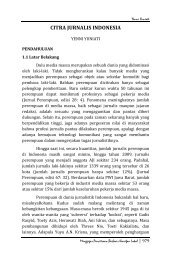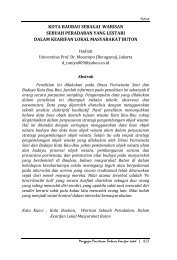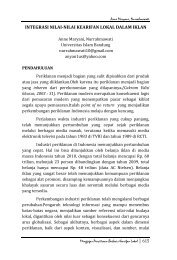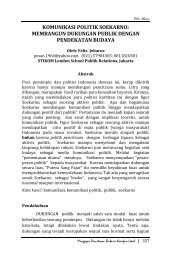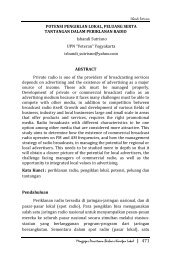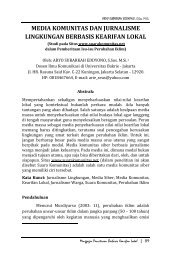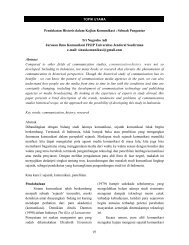New Vocabularies in Film Semiotics
New Vocabularies in Film Semiotics
New Vocabularies in Film Semiotics
You also want an ePaper? Increase the reach of your titles
YUMPU automatically turns print PDFs into web optimized ePapers that Google loves.
190 CINEMATIC REALISM<br />
photographic reproduction, for both Kracauer and Baz<strong>in</strong>, assured the<br />
essential “objectivity” of film. That the photographer, unlike the pa<strong>in</strong>ter or<br />
poet, cannot work <strong>in</strong> the absence of a model, was presumed to guarantee<br />
an ontological bond between the photographic representation and what it<br />
represents. S<strong>in</strong>ce photochemical processes <strong>in</strong>volve an <strong>in</strong>dexical l<strong>in</strong>k between<br />
the photographic analogon and its referent, c<strong>in</strong>ematography bears<br />
unimpeachable witness to “th<strong>in</strong>gs as they are.” Th<strong>in</strong>kers as diverse as<br />
Panofsky, Kracauer, Baz<strong>in</strong> and Pasol<strong>in</strong>i emphasize film as an “art of<br />
reality” and even Metz, <strong>in</strong> his early work, contrasted the “arbitrary” and<br />
“unmotivated” l<strong>in</strong>guistic sign with the “analogous” and “motivated”<br />
photographic image.<br />
IDEOLOGY AND THE CAMERA<br />
In the wake of the events of May 1968, the French film journals Cahiers du<br />
C<strong>in</strong>éma and C<strong>in</strong>étique sought to extrapolate Althusser’s theoretical<br />
practice <strong>in</strong> order to forge a scientific understand<strong>in</strong>g of the c<strong>in</strong>ema as an<br />
ideological apparatus. Theorists such as Marcel<strong>in</strong> Pleynet, Jean-Louis<br />
Baudry and Jean-Louis Comolli questioned the idealization of the c<strong>in</strong>ema’s<br />
presumably <strong>in</strong>herent truth-tell<strong>in</strong>g capabilities, claim<strong>in</strong>g that bourgeois<br />
ideology was built <strong>in</strong>to the c<strong>in</strong>ematic apparatus itself. Jean-Louis Baudry<br />
argued, <strong>in</strong> “The Ideological Effects of the Basic C<strong>in</strong>ematographic<br />
Apparatus,” that the apparatus must be exam<strong>in</strong>ed <strong>in</strong> the context of the<br />
ideology which produced it as an effect, contend<strong>in</strong>g that the specificity of<br />
the c<strong>in</strong>ematic apparatus as a mode of representation and as a material<br />
practice consisted <strong>in</strong> its way of literally realiz<strong>in</strong>g the very processes by<br />
which the subject is constructed <strong>in</strong> ideology. The specific function of the<br />
c<strong>in</strong>ema, as support and <strong>in</strong>strument of ideology, was to constitute the<br />
subject by the illusory delimitation of a central location, thus creat<strong>in</strong>g a<br />
“phantasmization” of the subject and collaborat<strong>in</strong>g <strong>in</strong> the ma<strong>in</strong>tenance of<br />
bourgeois idealism (Baudry, <strong>in</strong> Rosen 1986). Marcel<strong>in</strong> Pleynet po<strong>in</strong>ted out<br />
(<strong>in</strong> Harvey 1978: 159) that the technology of the camera was conditioned<br />
by the CODE OF RENAISSANCE PERSPECTIVE, i.e. the convention of<br />
pictorial representation developed by the Renaissance pa<strong>in</strong>ters of the<br />
quattrocento, who noted that the perceived size of objects <strong>in</strong> nature varies<br />
proportionally with the square of the distance from the eye.<br />
The quattrocento pa<strong>in</strong>ters <strong>in</strong>corporated this code <strong>in</strong>to their pa<strong>in</strong>t<strong>in</strong>gs <strong>in</strong><br />
order to project three-dimensional space onto a flat two-dimensional<br />
surface, thus produc<strong>in</strong>g the impression of depth, an <strong>in</strong>novation which<br />
ultimately led to impressive trompe-l’oeil effects. As absorbed <strong>in</strong>to the<br />
camera, this code functioned, as Marcel<strong>in</strong> Pleynet put it, “to rectify” any<br />
anomoly <strong>in</strong> perspective, so as to reproduce <strong>in</strong> its full authority the code of<br />
specular vision as it was def<strong>in</strong>ed by Renaissance humanism.” 1 By<br />
<strong>in</strong>corporat<strong>in</strong>g the perspectiva artificialis <strong>in</strong>to its reproductive apparatus, the


